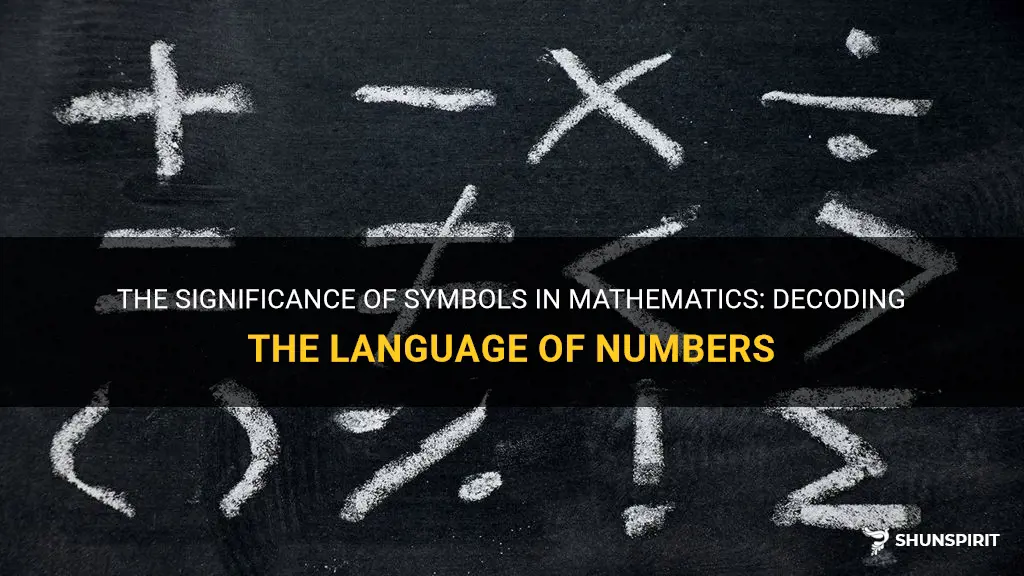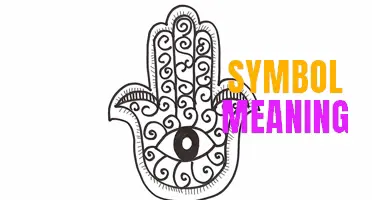
Symbols are like a secret code that mathematicians use to unlock the mysteries of numbers and equations. Just like words represent concepts and ideas, symbols represent mathematical concepts and operations. They are the building blocks of mathematical language, allowing mathematicians to communicate complex ideas in a concise and precise manner. From the familiar plus sign to the mysterious Greek letters, symbols are the keys to understanding the language of math. In this article, we will explore the fascinating world of mathematical symbols and discover the meaning behind the mathematical code.
What You'll Learn
- What is the definition of a symbol in mathematics?
- How are symbols used in mathematical equations?
- Can symbols have different meanings depending on the context in mathematics?
- How do mathematicians assign meaning to new symbols?
- Are symbols necessary for understanding and communicating mathematical concepts?

What is the definition of a symbol in mathematics?
In mathematics, a symbol is a representation of a quantity or an operation. It can be a numeral, a letter, a shape, or any other object that is used to convey mathematical meaning.
Symbols are used to simplify mathematical expressions and equations. They allow mathematicians to express complex concepts in a concise and precise way. By using symbols, mathematical ideas can be communicated efficiently, regardless of language barriers.
A symbol can have different meanings depending on the context. For example, the symbol "x" can represent an unknown number in algebraic equations. In geometry, it can represent a coordinate on a Cartesian plane. In calculus, it can represent a variable in a function.
Symbols are also used to represent mathematical operations. The "+" symbol represents addition, the "-" symbol represents subtraction, the "*" symbol represents multiplication, and the "/" symbol represents division. These symbols allow mathematicians to perform calculations and solve problems.
Symbols in mathematics can also have specific meanings, known as mathematical notation. For example, the symbol "π" represents the mathematical constant pi, which is the ratio of a circle's circumference to its diameter. The symbol "∑" represents the summation of a series of numbers. The symbol "∫" represents the integral of a function.
In addition to these standard symbols, mathematicians also use notation to represent mathematical relationships and properties. For example, the symbol "=" represents equality, the symbol "<" represents less than, and the symbol ">" represents greater than. These symbols allow mathematicians to make statements and prove theorems.
In conclusion, symbols are an essential part of mathematics. They allow mathematicians to represent quantities, operations, and relationships in a concise and precise way. By using symbols, mathematical ideas can be communicated efficiently and accurately. Whether it's a numeral, a letter, or a shape, a symbol in mathematics helps to simplify mathematical expressions and equations.
Decoding the Hidden Meanings of No Symbol Pokémon Cards
You may want to see also

How are symbols used in mathematical equations?
In mathematics, symbols are used extensively to represent various mathematical concepts, operations, and relationships. These symbols allow mathematicians to express complex ideas concisely and make computations and calculations more efficient. They serve as a universal language for communicating mathematical ideas and are used in equations, formulas, and mathematical statements.
Symbols in mathematical equations provide a means for representing mathematical objects, variables, and constants. For example, the symbol "x" is often used to represent an unknown quantity or variable in an equation. By assigning a symbol to an unknown quantity, mathematicians can manipulate the equation to solve for that variable.
Mathematical symbols are also used to represent arithmetic operations. The symbol "+" is used to represent addition, while "−" represents subtraction. Multiplication is represented by the symbol "×" or simply by placing two quantities next to each other. Division is denoted by the symbol "÷" or by using a fraction bar.
Symbols are also employed to denote special mathematical operations, such as exponents and logarithms. The symbol "^" is used to indicate exponentiation, where a number is raised to a certain power. For example, 2^3 represents 2 raised to the power of 3, which equals 8. Logarithms, on the other hand, are denoted by the symbol "log". For instance, log10(100) represents the logarithm of 100 to the base 10, which equals 2.
Furthermore, symbols are used to denote mathematical relationships and inequalities. The equal sign (=) is used to indicate that two quantities are equal, while the not equal sign (≠) denotes inequality. Less than (<) and greater than (>) symbols are used to show the relationship between two quantities. Additionally, symbols such as ≤ (less than or equal to) and ≥ (greater than or equal to) are used to represent inclusive inequalities.
Symbols in mathematical equations also play a crucial role in expressing mathematical formulas. Formulas are mathematical relationships between different variables, and symbols are used to represent each variable involved. These formulas allow mathematicians to make predictions and analyze various phenomena across different fields such as physics, chemistry, and engineering.
In conclusion, symbols are essential in mathematical equations as they allow mathematicians to represent objects, variables, and operations. They provide a compact and efficient way to express complex mathematical ideas, making calculations and computations easier. Symbols also help represent relationships, inequalities, and formulas, enabling mathematicians to solve problems and make meaningful predictions. Without symbols, mathematical equations would be cumbersome and difficult to comprehend.
Exploring the Meaning Behind the Triangle Symbol in Mathematics
You may want to see also

Can symbols have different meanings depending on the context in mathematics?
Symbols are an integral part of mathematics and are used to represent various concepts and quantities. In mathematics, symbols are often given specific meanings, and these meanings are generally consistent across different contexts. However, there are instances where symbols can have different meanings depending on the context in which they are used.
One example of a symbol with different meanings in different contexts is the symbol "+". In its most commonly used context, "+" represents addition. For example, in the equation 2 + 3 = 5, the symbol "+" indicates that the numbers 2 and 3 are being added together to get a sum of 5. However, in a different context, the symbol "+" can represent concatenation. For example, in the equation "Hello" + "World" = "HelloWorld", the symbol "+" is used to combine the strings "Hello" and "World" to form a single string "HelloWorld".
Another example of a symbol with multiple meanings is the symbol "x". In its most common context, "x" represents an unknown variable. For example, in the equation 2x = 8, the symbol "x" represents an unknown value that, when multiplied by 2, equals 8. However, in a different context, "x" can represent multiplication. For example, in the equation 3x = 12, the symbol "x" represents a multiplication operation, indicating that the number 3 is being multiplied by an unknown value to get a product of 12.
Similarly, the symbol "=" is often used to indicate equality between two quantities. For example, in the equation x + 5 = 10, the symbol "=" indicates that the expressions "x + 5" and "10" are equal. However, in other contexts, the symbol "=" can represent assignment. For example, in programming languages, the symbol "=" is used to assign a value to a variable. In the statement "x = 5;", the symbol "=" assigns the value 5 to the variable "x".
These examples illustrate that symbols can indeed have different meanings depending on the context in mathematics. It is important to consider the specific context in which a symbol is being used in order to correctly interpret its meaning. In mathematics, using symbols with consistent and well-defined meanings is crucial for clear communication and accurate calculations.
The Symbolic Meaning Behind a Breathe Tattoo: Exploring the Power of Every Breath
You may want to see also

How do mathematicians assign meaning to new symbols?
Mathematics is often seen as a language of its own. Just as words have definitions and meanings, mathematicians need symbols to represent concepts and ideas. But how do mathematicians decide on the meaning of new symbols? This process involves careful consideration and consensus among the mathematical community.
When it comes to assigning meaning to new symbols, mathematicians follow a set of guidelines and principles. The first step is to ensure that the symbol is distinct and doesn't conflict with any existing symbols or concepts. This helps to avoid confusion and ambiguity in mathematical notation.
Next, mathematicians consider the context in which the symbol will be used. They look at its intended purpose and the mathematical ideas it is meant to represent. And when possible, they try to choose symbols that are intuitive and can be easily understood by other mathematicians.
Once a symbol is proposed, mathematicians engage in a process of peer review. They present their new symbol to the mathematical community through conferences, journals, and other forums. Fellow mathematicians will then assess the symbol's validity and usefulness, offering feedback and suggestions for improvement.
This peer review process is crucial in establishing a consensus within the mathematical community. If a symbol is widely accepted and incorporated into mathematical literature, it becomes part of the mathematical language. However, if there is significant disagreement or confusion surrounding the symbol, it may be rejected or modified.
Symbols in mathematics are not assigned meaning arbitrarily. They are carefully chosen and refined to ensure clarity and consistency in mathematical communication. This is especially important when dealing with abstract mathematical concepts that can be difficult to describe in words alone.
Symbols also play a role in mathematical notation. Mathematicians use symbols and notation to represent mathematical operations, equations, and relationships. Through the use of symbols, complex mathematical ideas can be expressed concisely and precisely.
In some cases, mathematicians may even need to invent completely new symbols to represent new mathematical concepts. This requires creativity and ingenuity, as well as a deep understanding of the underlying mathematics. These new symbols must then go through the same process of review and acceptance by the mathematical community.
Overall, the assignment of meaning to new symbols in mathematics is a collaborative and iterative process. Mathematicians rely on the collective wisdom and expertise of their peers to ensure that symbols are clear, intuitive, and consistent with existing mathematical knowledge. Through careful consideration and review, new symbols become an integral part of the mathematical language, allowing mathematicians to express and explore complex ideas in a concise and precise manner.
Understanding the Nissan Titan Dashboard Symbols and Their Meanings
You may want to see also

Are symbols necessary for understanding and communicating mathematical concepts?
Mathematics is a language that allows us to describe and understand the world around us. It is a universal language that transcends cultural and linguistic barriers. While symbols are not the only way to understand and communicate mathematical concepts, they are an essential tool for mathematicians and students to communicate and manipulate complex ideas.
Symbols provide a concise and precise way to represent mathematical concepts. They allow mathematicians to express ideas and relationships in a compact and efficient manner. For example, the symbol "+" represents the operation of addition, while the symbol "x" represents the operation of multiplication. These symbols make it easy for mathematicians to perform calculations and express mathematical relationships.
Symbols also allow mathematicians to generalize mathematical concepts. By using symbols, mathematicians can create formulas and equations that can be applied to a wide range of situations. For example, the equation "y = mx + b" represents a linear equation, where "m" represents the slope of the line and "b" represents the y-intercept. This equation can be used to solve a variety of problems, from finding the equation of a line to predicting future values based on a pattern.
Symbols also play a crucial role in mathematical proofs. Proofs are the cornerstone of mathematics, as they provide a rigorous and logical foundation for mathematical arguments. Symbols allow mathematicians to express the steps and logic of a proof in a concise and unambiguous way. By using symbols, mathematicians can communicate complex ideas and arguments without the need for lengthy explanations.
Symbols are not only important for mathematicians but also for students learning mathematics. Symbols provide a visual representation of mathematical concepts, making it easier for students to grasp and understand abstract ideas. For example, when learning about fractions, students use symbols such as "½" to represent the concept of a half. These symbols help to concrete the abstract concept of fractions and make it more accessible to students.
Symbols also help students to solve problems and perform calculations. By learning and understanding the meaning and operations associated with symbols, students can solve equations, simplify expressions, and perform calculations in a systematic and efficient manner. Symbols provide structure and organization to mathematical problems, helping students to break down complex problems into more manageable steps.
In conclusion, symbols are necessary for understanding and communicating mathematical concepts. They allow mathematicians to express ideas and relationships in a concise and precise manner, generalize mathematical concepts, and construct rigorous proofs. Symbols also play a crucial role in helping students learn and understand abstract mathematical concepts, solve problems, and perform calculations. While symbols are not the only way to represent and communicate mathematical ideas, they are an essential tool for mathematicians and students alike.
Unraveling the Mystery: Exploring the Symbols and Meanings of Pysanky Eggs
You may want to see also
Frequently asked questions
In mathematics, a symbol is a character or shape used to represent a mathematical object, operation, or relationship. Symbols are used to make mathematical notation more concise and easier to understand. They can represent numbers, variables, functions, operations, and more.
Yes, symbols can have different meanings in different mathematical contexts. For example, the symbol "+" can represent addition in arithmetic, concatenation in string manipulation, or the positive sign in algebra. The context and the surrounding mathematical notation help determine the meaning of a symbol.
While some symbols may be commonly used and universally understood in mathematics, not all symbols have a universal meaning. Different branches of math or different contexts may have their own set of symbols and conventions. However, there are some symbols that are widely recognized and understood among mathematicians regardless of the specific field of study.







